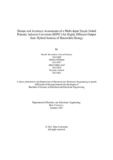| dc.contributor.advisor | Azad, A. K. M. Abdul Malek | |
| dc.contributor.author | Rakeen, Sheikh Mustahsin Ahmed | |
| dc.contributor.author | Mahmud, Tahmin | |
| dc.contributor.author | Araf, Afrid Uddin | |
| dc.contributor.author | Ahmed, Nayeem | |
| dc.date.accessioned | 2022-01-04T05:57:31Z | |
| dc.date.available | 2022-01-04T05:57:31Z | |
| dc.date.copyright | 2021 | |
| dc.date.issued | 2021 | |
| dc.identifier.other | ID 18121029 | |
| dc.identifier.other | ID 18121027 | |
| dc.identifier.other | ID 18121074 | |
| dc.identifier.other | ID 18121021 | |
| dc.identifier.uri | http://hdl.handle.net/10361/15822 | |
| dc.description | This thesis is submitted in partial fulfillment of the requirements for the degree of Bachelor of Science in Electrical and Electronic Engineering, 2021. | en_US |
| dc.description | Cataloged from PDF version of thesis. | |
| dc.description | Includes bibliographical references (pages 165-174). | |
| dc.description.abstract | In this thesis, a hybrid topology of an off-grid energy-harvesting system (by integrating Solar Photovoltaic (PV) Module with Bicycle Dynamo Generator) using a DC-DC multi-input single-output (MISO) single-ended primary inductor converter (SEPIC) has been proposed for isolated islands. A conventional SEPIC based SISO converter circuit was designed for the boost mode operation and its performance was compared with our proposed hybrid topology of the SEPIC based MISO converter system. The prototype of the proposed hybrid system has been developed by following an optimum design approach for small-scale performance analysis. The MISO SEPIC circuit has been designed to be operated at a practical input voltage of DC 12.1 V and an approximate output voltage of DC 53 V with 10W output power at the load side. To get the maximum voltage at the output end, the operating duty cycle for the proposed converter circuit is recorded as 81.49% with a gain of 4.4. From the hardware analysis and field-test data, we obtain and calculate an efficiency rate of 91.6% for the proposed prototype. A detailed and rigorous investigation of the proposed topology has been carried out through software simulation using MATLAB while considering the Solar PV Panel as Source-I and a feedback-controlled Bicycle Dynamo Generator as the Source-II. Different intermittence conditions, solar irradiance, seasonal variation, day-night behavior, power outage and other factors were taken into consideration while performing both the hardware and software analysis. Moreover, to secure a better understanding of the maximum performance of the two renewable energy sources, separate outdoor analysis was performed for the Solar PV Panel and the Bicycle Dynamo Generator. Solar energy has been a promising tool as an inexhaustible and clean energy for decades. From off-grid small installations to large scale photovoltaic plants, solar energy has become an integral part of our life. Due to the vicissitudes of atmospheric behavior, the PV Module alone can not harvest optimum electrical energy from the sun. So, this is where our proposed topology stands out. Our proposed model instills the possibilities of renewable energy, with the hope that it would ultimately reduce the total demand from the national grid and ensure utter energy efficiency inside Bangladesh and beyond. | en_US |
| dc.description.statementofresponsibility | Sheikh Mustahsin Ahmed Rakeen | |
| dc.description.statementofresponsibility | Tahmin Mahmud | |
| dc.description.statementofresponsibility | Afrid Uddin Araf | |
| dc.description.statementofresponsibility | Nayeem Ahmed | |
| dc.format.extent | 184 pages | |
| dc.language.iso | en | en_US |
| dc.publisher | Brac University | en_US |
| dc.rights | Brac University theses are protected by copyright. They may be viewed from this source for any purpose, but reproduction or distribution in any format is prohibited without written permission. | |
| dc.subject | Hybrid multi-port converter | en_US |
| dc.subject | SEPIC converter | en_US |
| dc.subject | Power supplies | en_US |
| dc.subject | Topology | en_US |
| dc.subject | Voltage optimization | en_US |
| dc.subject.lcsh | Renewable energy sources | |
| dc.subject.lcsh | Photovoltaic power systems | |
| dc.title | Design and accuracy assessment of a multi-input single Ended Primary Inductor Converter (SEPIC) for highly efficient output from hybrid sources of renewable energy | en_US |
| dc.type | Thesis | en_US |
| dc.contributor.department | Department of Electrical and Electronic Engineering, Brac University | |
| dc.description.degree | B. Electrical and Electronic Engineering | |

